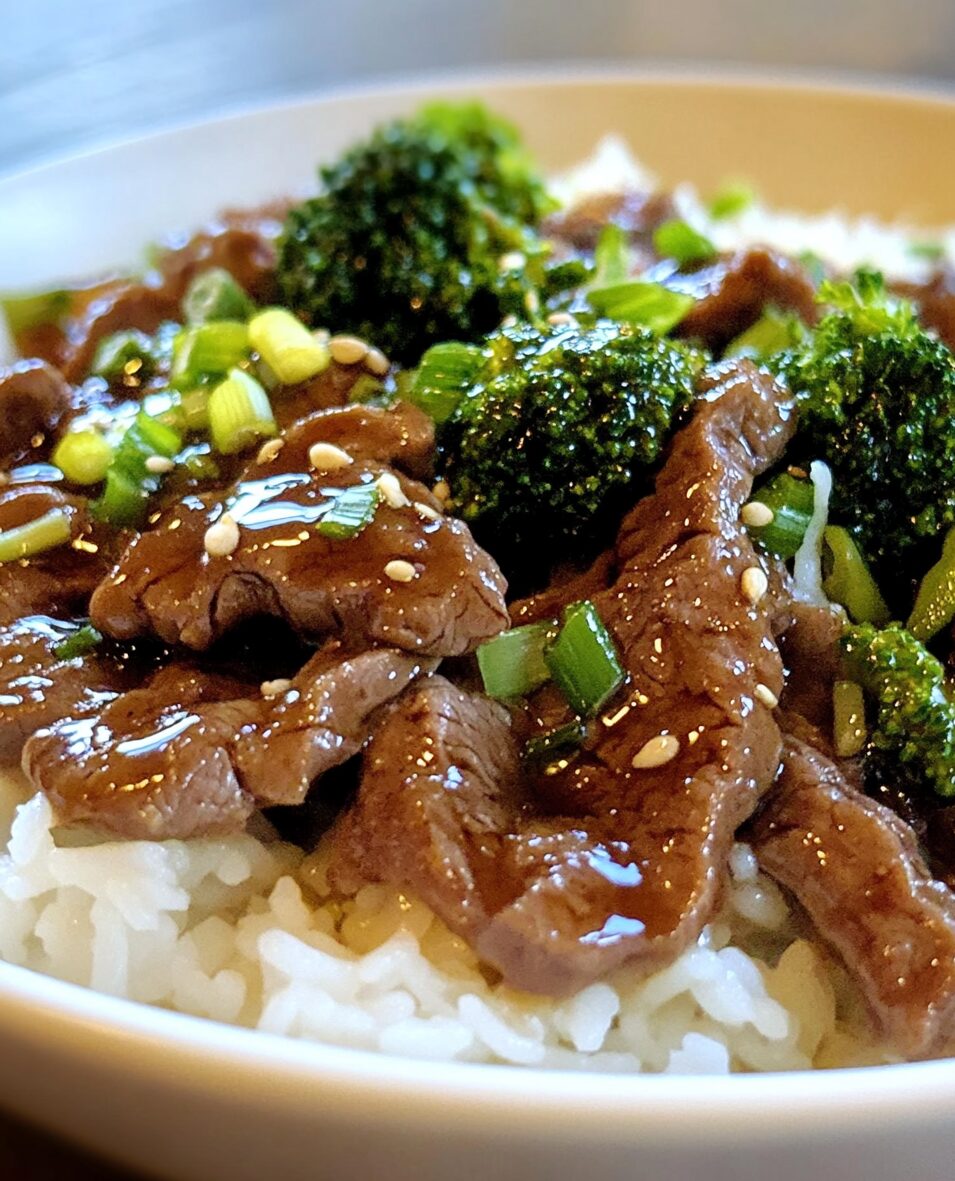Beef Teriyaki is a classic Japanese dish that blends tender strips of beef with a flavorful, sweet-savory teriyaki sauce. The umami-rich combination of soy sauce, mirin, and brown sugar creates a glossy glaze that clings to the beef, making each bite burst with delicious flavor. Garnished with sesame seeds and chopped green onions, this dish is as visually appealing as it is satisfying.
Served over fluffy white rice, Beef Teriyaki is the perfect balance of protein, sweetness, and umami. It’s a quick and easy meal to whip up on busy weeknights or whenever you’re craving a comforting, flavorful dinner. This dish pairs beautifully with steamed vegetables or a light salad, making it a versatile choice for any occasion.
Full Recipe
Ingredients:
- 1 lb beef sirloin, thinly sliced
- 1/4 cup soy sauce
- 1/4 cup mirin (sweet rice wine)
- 2 tbsp brown sugar
- 2 tbsp sake (optional)
- 2 tbsp vegetable oil
- 2 garlic cloves, minced
- 1 tsp grated ginger
- 1 tbsp cornstarch mixed with 2 tbsp water (slurry)
- Cooked white rice (for serving)
- Sesame seeds (optional garnish)
- Green onions, chopped (optional garnish)
Directions:
- In a bowl, mix soy sauce, mirin, brown sugar, sake, garlic, and ginger. Add beef slices and marinate for 20 minutes.
- Heat vegetable oil in a skillet over medium-high heat. Drain the beef from the marinade and sear the slices until browned, about 3-4 minutes.
- Pour the marinade into the skillet and bring to a simmer.
- Stir in the cornstarch slurry to thicken the sauce. Cook for 2-3 minutes, or until the sauce coats the beef.
- Serve the teriyaki beef over a bed of white rice, and garnish with sesame seeds and green onions if desired.
Prep Time: 10 minutes | Cooking Time: 15 minutes | Total Time: 25 minutes
Kcal: 350 kcal | Servings: 4 servings
History of Beef Teriyaki:
Teriyaki sauce, a signature element of Japanese cuisine, has been enjoyed for centuries. The term “teriyaki” is derived from teri (glaze or shine) and yaki (grill or broil). Traditionally, teriyaki was used to marinate fish like mackerel and yellowtail before grilling, giving the fish a glossy, caramelized appearance. This cooking method became popular in the Edo period (1603-1868), when soy sauce and mirin were commonly used in Japanese households.
While the original teriyaki was primarily associated with fish, Beef Teriyaki became popular later, especially in Western countries. Japanese immigrants introduced teriyaki to the U.S. in the 20th century, where it evolved to include meat such as beef, chicken, and pork, to cater to local tastes. The version we know today, especially in places like the U.S., is often sweeter and richer than traditional Japanese teriyaki, reflecting a blend of Japanese and Western culinary influences.
Nutritional Benefits of Beef Teriyaki:
- Rich in Protein:
Beef is an excellent source of high-quality protein, essential for muscle repair, growth, and overall health. A serving of Beef Teriyaki provides a significant amount of protein, making it a good choice for those looking to maintain or build muscle. - Iron-Rich:
Beef is a great source of heme iron, which is more easily absorbed by the body compared to plant-based iron sources. Iron is crucial for producing red blood cells and preventing anemia. - B Vitamins:
Beef is packed with B vitamins, especially B12, which supports brain function and energy production. Other B vitamins in beef help convert food into energy and maintain healthy skin and nerves. - Balanced Macronutrients:
When served with rice, Beef Teriyaki offers a balanced meal with carbohydrates for energy, protein for muscle building, and healthy fats from the cooking oil. - Soy Sauce Benefits:
While soy sauce is often high in sodium, it also contains beneficial antioxidants and small amounts of minerals like manganese. Using low-sodium soy sauce can help manage salt intake while still enjoying the umami flavor. - Customization for Added Nutrients:
You can enhance the nutritional profile of Beef Teriyaki by adding vegetables like broccoli, bell peppers, and carrots. These vegetables provide vitamins A, C, and K, as well as dietary fiber, promoting better digestion and overall health.
Considerations:
While Beef Teriyaki is flavorful and nutritious, moderation is key. Traditional teriyaki sauce can be high in sugar and sodium, so using lower-sodium soy sauce and reducing added sugars can make the dish healthier without sacrificing flavor. You can also opt for leaner cuts of beef to reduce saturated fat content.
Extended History of Teriyaki and Its Global Influence:
The origins of teriyaki can be traced back to Japan during the Edo period, where the method of grilling or broiling meats and fish after marinating them in a sauce made from soy sauce, mirin, and sugar became popular. While the Japanese primarily used teriyaki for seafood, particularly fish like mackerel and yellowtail, the concept quickly spread beyond Japan’s borders as global travel and trade expanded.
In the 20th century, Japanese immigrants, particularly in Hawaii and the West Coast of the United States, began adapting the teriyaki cooking style to local ingredients. The use of beef, chicken, and pork became more common as these proteins were more widely available and popular in Western diets. Over time, teriyaki became a staple in many Japanese-American fusion dishes.
In Hawaii, teriyaki sauce was often enhanced with local flavors like pineapple juice, giving it a sweeter, more tropical twist. This adaptation became popular across the mainland U.S., where American-style teriyaki often features a thicker, sweeter sauce compared to the original Japanese version. Beef Teriyaki is now a common dish in many Japanese-American restaurants and is beloved for its savory-sweet balance that appeals to a broad audience.
Nutritional Advantages of Beef Teriyaki in a Modern Diet:
- A Well-Balanced Meal:
Beef Teriyaki can easily fit into a balanced diet. When served with a portion of white or brown rice, the meal includes complex carbohydrates, which are essential for energy, along with lean protein from the beef. Adding vegetables like broccoli, carrots, or bell peppers enhances the nutrient profile by contributing fiber, vitamins, and minerals, creating a well-rounded dish. - Omega-3 and Healthy Fats:
When prepared using grass-fed beef, the dish can also provide omega-3 fatty acids, which support heart health and reduce inflammation. Additionally, healthy fats used for cooking (such as olive oil or avocado oil) can improve cardiovascular health by reducing bad cholesterol levels. - Promotes Satiety:
Beef Teriyaki is not just high in protein but also rich in fats, which together promote a feeling of fullness. This helps with weight management by reducing the likelihood of overeating at subsequent meals. - Ginger and Garlic Benefits:
The traditional ingredients of garlic and ginger in the marinade aren’t just for flavor—they also offer health benefits. Garlic has been linked to improved immune function and heart health, while ginger aids in digestion and has anti-inflammatory properties. - Antioxidants from Soy Sauce:
Soy sauce, a core component of teriyaki, contains antioxidants, which help protect cells from oxidative stress. While it’s true that soy sauce can be high in sodium, choosing low-sodium versions can help maintain the health benefits without excessive salt intake. Additionally, fermented soy products like soy sauce may contribute to gut health by promoting the growth of beneficial bacteria. - Versatile Dietary Adaptations:
Beef Teriyaki can be adapted to fit different dietary needs. For example:- Gluten-Free: Using tamari instead of soy sauce makes this dish gluten-free.
- Low-Carb: You can substitute rice with cauliflower rice for a low-carb option.
- Low-Sugar: Reducing the sugar content or using a natural sweetener like honey can lower the glycemic load for those watching their sugar intake.
- A High-Iron and Zinc Boost:
In addition to protein, beef is one of the best natural sources of iron and zinc. Iron helps transport oxygen in the blood, while zinc supports the immune system and helps with wound healing. These are particularly important for individuals with high physical demands or those prone to anemia.
Conclusion:
Beef Teriyaki is a perfect blend of traditional Japanese flavors and modern culinary adaptations. Its origins in Japan as a method of grilling fish evolved into a globally loved dish that now includes a variety of proteins like beef. This flavorful, umami-rich dish offers both a satisfying taste and numerous nutritional benefits, from high-quality protein and essential vitamins to the antioxidants found in its key ingredients like soy sauce, garlic, and ginger.
With its versatility, Beef Teriyaki can easily be customized to suit different dietary needs, whether you’re aiming for gluten-free, low-carb, or low-sugar options. It can be served with rice, noodles, or even stir-fried vegetables, making it adaptable for any meal.
Today, Beef Teriyaki continues to be a favorite for home cooks and restaurant diners alike, thanks to its ease of preparation, balanced nutrition, and irresistible sweet-savory flavor. Whether you’re looking for a quick weeknight dinner or a dish that will impress your guests, Beef Teriyaki brings a delicious, comforting taste of Japanese cuisine to your table.

